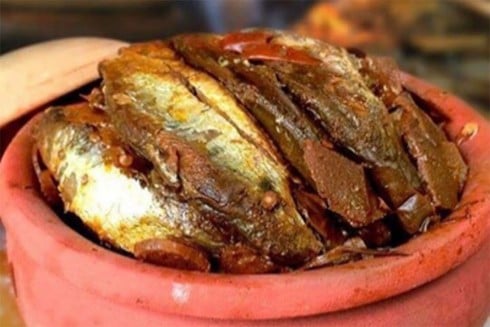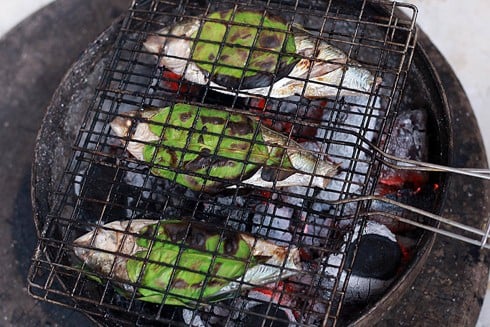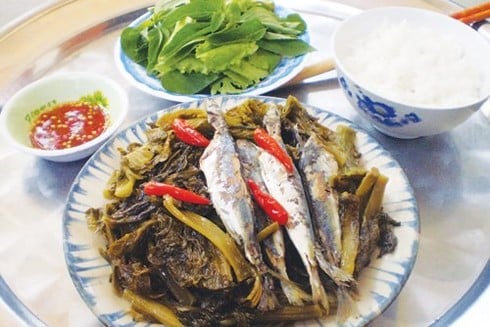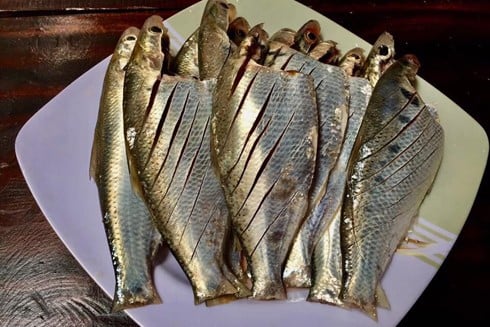Every year, around the end of February and the beginning of March of the lunar calendar, when spring rains warm the river surface, when the red cotton flowers bloom, and schools of sardines swim back from the sea to the river, that is also the time when fishing villages along the Red River bustle about catching sardines, an "exclusive" specialty of the Red River.
From the East Sea to the Red River
Fishermen living along the river all know the story of the sardine by heart. Sardines are transformed from sardines. Every year in the fall, when the rice crop ends, sardines fly out to sea and transform into sardines. In the spring, the fish swim back to the river and transform back into sardines at the source.
Of course, the story is sometimes full of fantasy, but it reminds people of the migratory habits of these two special species.
Science has confirmed that sardines have a very precise biological clock, which is basically the same as the biological clock of salmon in the West.
Sardine eggs hatch in fresh water, so when they hatch, the young fish grow and travel miles down the river to the ocean. Then, in the spring, when breeding season comes, they swim upstream to the exact spot where they were born to lay their eggs.

Sardines are silvery white, flat, with soft and small scales, sweet meat, and many soft bones. Sardines are abundant in estuaries, but are only found in the Red River, and people explain that this is because the fish are immersed in the fertile alluvial particles of the mother river.
Fish are more delicious when caught in inland rivers. Fish near the river mouth are less fragrant and sweet, fish caught in the sea even have smelly meat.
Eating sardines is an art. That is, there is a specific recipe for preparing them, and this recipe must have been developed by the people of the Red River Delta for hundreds of years.
The fish is cleaned, then diagonally cut into the fish body. Because the fish body is thin and has solid intestines, the fish is not cut open in the usual way, but cut at a small angle, between the gills and intestines, this way the intestines are clean, clean and the gall bladder is not broken.
Sardines go particularly well with turmeric and ginger (unlike lake or sea fish which go well with galangal), so there are many ways to prepare fish involving these two unique spices.

Delicious dishes made from sardines
The pinnacle of sardine dishes and also the most popular dish is crispy fried sardine. After cleaning the fish, making many diagonal cuts on the body, it is marinated with a little turmeric water (crushed turmeric, filtered to remove the pulp) and a little salt, then fried until crispy and dipped in ginger fish sauce. Because the fish bones are soft, when fried crispy, you can eat both the meat and bones, the meat is fragrant, fatty and rich.
Another delicious dish made from sardines that not everyone has ever enjoyed is grilled sardines with pomelo leaves. The seasoning for marinating the fish is quite simple, some people like to marinate it with a little turmeric or ginger, some people don't like to marinate it at all to keep the original flavor. Roll pomelo leaves around the fish and grill it until golden brown on a charcoal stove. Grilling fish seems simple but turns out to be quite complicated because it requires skill.
Medium heat, turn the fish evenly so that it is golden brown and not burnt. Keep turning until the aroma of grapefruit leaves and fish blend together. When eating, peel off the grapefruit leaves and discard. Grilled fish with grapefruit leaves has a very distinctive and unique flavor, you will remember it forever after eating it, and then have to wait until the next season to enjoy it again.
Every time the sardine season is in full swing, many housewives show off their skills in making sardine patties. The fish is chopped very finely, including the bones, then mixed with a portion of meat, a portion of fish, pepper, chili powder, chopped betel leaves, crushed and chopped shallots, and a little green onion, then rolled in the betel leaves and fried until golden brown on both sides.

The residents of the Red River Delta also have many ways to process fish into delicious dishes such as sardines cooked with melon soup, cooked with kohlrabi. Then there are braised sardines, sardines braised with ginger or turmeric, more fragrant braised with ginger leaves or young ginger stems, then braised with melon, braised with green bananas...
This season, fishing villages along the Red River all cast nets to catch sardines. Among them, Vu Dien ferry (Hoang Hanh commune, Hung Yen city, Hung Yen province) is considered the largest sardine barn.
The water level here is deep, and it is the confluence of the Red River, Luoc River, and Nam Dinh River, so there are many fish.
During the sardine season, this place becomes a fish market. The price of sardine here ranges from 20,000 to 30,000 VND per kilogram. When entering the city, the price can be up to 50,000-70,000 VND per kilogram.
Sardine meat in season is often rich and fragrant, and the roe is even more delicious because it has a rich aroma. In the last days of spring, dishes made from sardine are indispensable in family meals. Sardine dishes are not only delicious dishes that many people love, but also dishes rich in the flavor of the homeland, making those who are far from home look forward to returning in spring.

This season, fishing villages along the Red River all cast nets to catch sardines. Among them, Vu Dien ferry (Hoang Hanh commune, Hung Yen city, Hung Yen province) is considered the largest sardine farm.
The water level here is deep, and it is the confluence of the Red River, Luoc River, and Nam Dinh River, so there are many fish.
When sardine season comes, this place becomes a fish market. Sardine meat in season is often delicious and fragrant, and the fish eggs are even more delicious because they have a rich, fragrant taste.
In the last days of spring, dishes made from sardine are indispensable in family meals. Sardine dishes are not only delicious dishes that many people love, but also dishes rich in the flavor of the homeland, making those who are far from home look forward to returning in spring.




![[Photo] Ready for the top competitions of Vietnamese table tennis](https://vphoto.vietnam.vn/thumb/1200x675/vietnam/resource/IMAGE/2025/5/18/9c547c497c5a4ade8f98c8e7d44f5a41)

![[Photo] General Secretary To Lam visits exhibition of achievements in private economic development](https://vphoto.vietnam.vn/thumb/1200x675/vietnam/resource/IMAGE/2025/5/18/1809dc545f214a86911fe2d2d0fde2e8)
























![[Infographic] Numbers about the 2025 High School Graduation Exam in Dong Thap Province](https://vphoto.vietnam.vn/thumb/402x226/vietnam/resource/IMAGE/2025/5/17/c6e481df97c94ff28d740cc2f26ebbdc)

![[Photo] National conference to disseminate and implement Resolution No. 66-NQ/TW and Resolution No. 68-NQ/TW of the Politburo](https://vphoto.vietnam.vn/thumb/1200x675/vietnam/resource/IMAGE/2025/5/18/adf666b9303a4213998b395b05234b6a)




























































Comment (0)